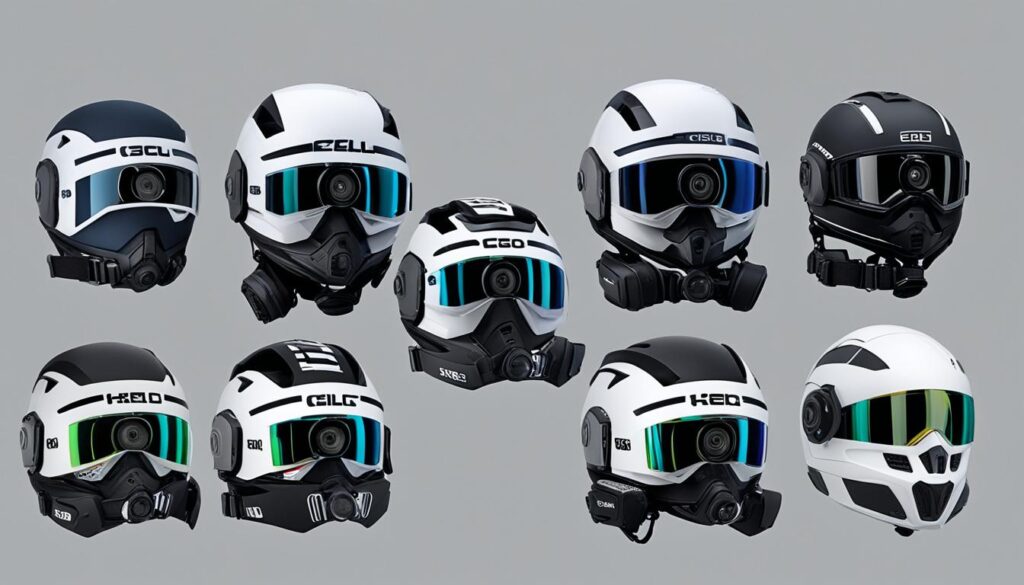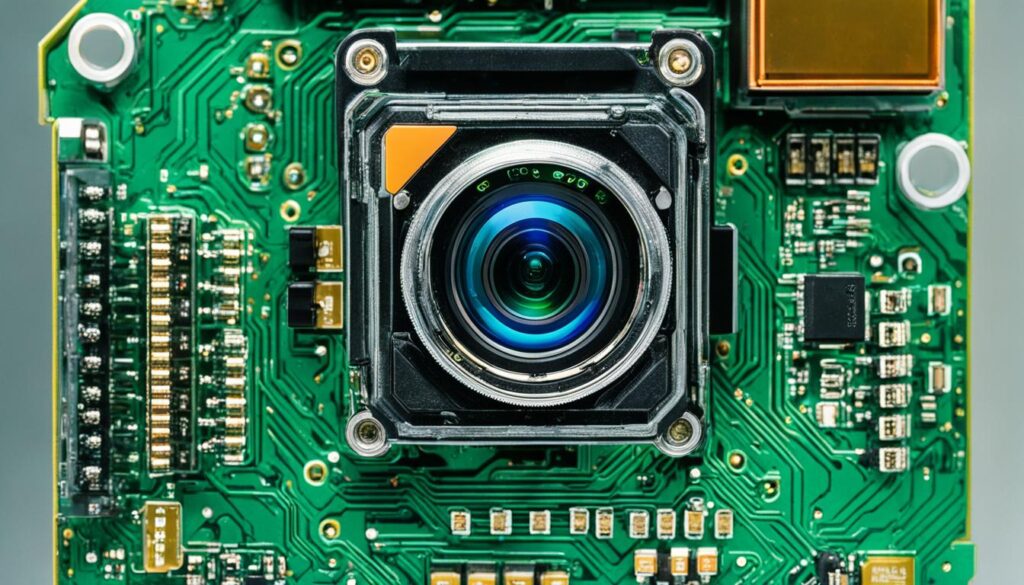
Have you ever wondered how helmet cameras have evolved over the years? From capturing exhilarating action shots to sharing personal experiences, helmet cameras have become a staple for adventurers, athletes, and storytellers alike. But where did it all begin? Let’s take a dive into the history of helmet cameras and discover the amazing journey of these action-packed devices.
Key Takeaways:
- Helmet cameras, also known as action cameras, have a rich history that dates back to the 1960s.
- Early innovators like Bob Sinclair and Mark Schulze paved the way for the development of helmet cameras.
- In 2004, GoPro introduced the first commercially available action camera, transforming the industry.
- Technological advancements have led to the emergence of smaller, more powerful helmet cameras with advanced features.
- Helmet cameras find applications in various fields, from sports and adventure to safety aids and military applications.
Early Innovations in Action Cameras (1960s-1990s)
In the 1960s, early attempts were made by several individuals to create action cameras by mounting cameras to helmets or other devices. These innovations laid the foundation for the development of action cameras as we know them today.
One notable example is Bob Sinclair, a skydiver who attached a camera to a fiberglass helmet in order to improve the stability of his video recordings for the show Ripcord. This early innovation showcased the potential for capturing thrilling first-person footage.
Additionally, Jackie Stewart, an F1 driver, experimented with wearing a still camera on his head. This allowed him to capture unique perspectives during races, providing viewers with a thrilling immersive experience.
Another noteworthy early innovator was Steve McQueen, who duct-taped a camera to his helmet during a daring motorcycle stunt. This inventive approach allowed him to capture incredible footage from his own point of view, adding excitement and realism to the final product.
Mark Schulze: Pioneering Helmet-Mounted Camera Innovator
Mark Schulze, a video maker, was among the early pioneers of helmet-mounted cameras. In 1987, Schulze mounted a VHS camera on his helmet to capture mountain biking footage. This groundbreaking approach enabled Schulze to document his thrilling rides and share them with others, showcasing the potential of helmet cameras for capturing adventurous activities.
| Early Innovators | Camera Innovations |
|---|---|
| Bob Sinclair | Camera attachment to fiberglass helmet for stability |
| Jackie Stewart | Experimentation with wearing a still camera on the head |
| Steve McQueen | Duct-taping a camera to the helmet for first-person footage |
| Mark Schulze | VHS camera mounted on a helmet for mountain biking footage |
The Rise of GoPro and the GoPro Era (2002-2012)
In 2002, Nicholas Woodman, a surfer and entrepreneur, had a visionary idea – a camera that could be attached to the body to capture action-packed moments. This idea led to the creation of the revolutionary GoPro camera, which was first introduced in 2004.
The early GoPro models, such as the GoPro Hero, were analog cameras with limited features. However, they quickly gained popularity in the action camera market due to their durability and versatility. Athletes, adventurers, and enthusiasts around the world realized the immense potential of capturing their adrenaline-fueled experiences from unique perspectives.
As digital advancements accelerated, GoPro cameras evolved to meet the growing demands of the market. Features such as Wi-Fi and Bluetooth connectivity, waterproof casings, and improved video quality were introduced, further enhancing the capabilities of GoPro cameras.
During the GoPro Era from 2002 to 2012, the action camera market experienced a significant shift. GoPro emerged as the dominant player, revolutionizing the way people capture and share their adventures.
GoPro not only provided individuals with a powerful tool to document their experiences but also created a thriving community of content creators. The GoPro platform became a hub for users to share their jaw-dropping footage, inspiring others to push their limits and explore the world from a different perspective.
As GoPro continued to innovate and improve its offerings, other players in the market began to follow suit, leading to fierce competition and further advancements in camera technology. The action camera market expanded, offering a range of options to cater to the diverse needs of users.
Digital Advancements in the GoPro Era
Throughout the GoPro Era, digital advancements played a pivotal role in shaping the action camera landscape. The introduction of Wi-Fi and Bluetooth connectivity allowed users to seamlessly transfer their footage to other devices for editing and sharing, revolutionizing the way content was created and distributed.
Waterproof casings became an essential feature in GoPro cameras, enabling users to capture stunning footage even in extreme weather conditions or aquatic environments. This breakthrough opened up new possibilities for underwater exploration and adventure sports documentation.
The video quality of GoPro cameras also saw significant improvements over the years, allowing users to capture high-definition footage that showcased the intensity and beauty of their experiences in vivid detail.
The Domination of GoPro
The rise of GoPro during the GoPro Era solidified its position as the market leader in the action camera industry. Its innovative products and dedication to meeting the needs of its users propelled GoPro to the forefront of the market.
GoPro’s success can be attributed to the visionary thinking of Nicholas Woodman and the company’s commitment to constant improvement. By understanding the needs of the action camera market and leveraging digital advancements, GoPro was able to capture the hearts of adventurers and become a household name synonymous with action-packed moments.
Over the years, GoPro has continued to innovate and expand its product lineup, introducing cameras with advanced features and capabilities. This relentless pursuit of excellence has cemented GoPro’s position as a leader in the action camera industry.
As we move beyond the GoPro Era, the action camera market remains vibrant and competitive. New players are emerging, technological advancements continue to push the boundaries of what is possible, and users around the world eagerly await the next revolution in camera technology.
Post GoPro Era and Technological Advances
After the groundbreaking success of GoPro, the action camera market witnessed significant growth and saw the emergence of numerous brands with their own innovative offerings. This post-GoPro era paved the way for remarkable technological advancements in the world of action cameras, transforming the way we capture and share our adventures.
The evolution of camera technology led to the development of smaller and more powerful action cameras that revolutionized the industry. These cameras now come equipped with an array of cutting-edge features that enhance the user experience, making them indispensable tools for capturing action-packed moments in various industries.
One of the key advancements in action cameras is the introduction of high-definition recording capabilities. With crystal-clear image quality and enhanced video resolution, users can relive their adventures with unparalleled clarity and detail. This advancement has facilitated the creation of breathtaking visuals, allowing filmmakers, sports enthusiasts, and adventurers to capture stunning footage.
Wireless connectivity is another significant feature that has transformed the way we interact with our action cameras. With the ability to connect wirelessly to other devices, such as smartphones or tablets, users can instantly transfer their footage, edit it on the go, and share their experiences with the world. This seamless connectivity has made it easier than ever to showcase our adventures in real-time.
Furthermore, waterproof enclosures have become an essential feature in modern action cameras. These robust and durable casings allow users to capture footage in challenging environments, including underwater exploration and extreme weather conditions. Waterproof action cameras have opened up a whole new world of possibilities, enabling us to capture breathtaking footage in previously inaccessible locations.
Helmet cameras have also seen advancements in terms of user-friendly features. On-screen menus provide easy access to camera settings, allowing users to make quick adjustments while on the move. Additionally, multiple mounts ensure versatile mounting options, enabling users to attach their cameras to different surfaces, such as helmets, bikes, or even drones. The availability of 3D capabilities has further elevated the immersive experience that helmet cameras offer, taking our adventures to new heights.
“With technological advancements and continuous innovation, action cameras have become more powerful, user-friendly, and versatile, enhancing our ability to capture and share our action-packed experiences.” – [Author Name]
Overall, the post-GoPro era has propelled the action camera market into new frontiers, driving continuous technological advancements and the incorporation of cutting-edge features. Action cameras have become an indispensable tool for sports enthusiasts, adventure junkies, and filmmakers alike, capturing the essence of thrilling moments with unrivaled precision.
| Technological Advancements | Camera Features |
|---|---|
| High-definition recording | – Crystal-clear image quality |
| Wireless connectivity | – Instant sharing and editing |
| Waterproof enclosures | – Thriving in challenging environments |
| User-friendly features | – On-screen menus |
| – Multiple mounts | |
| – 3D capabilities |
Applications of Helmet Cameras
Helmet cameras have found applications in various fields, serving as versatile tools for capturing personal experiences and enhancing storytelling. Let’s explore some of the key areas where helmet cameras are widely used:
Sports Enthusiasts
Sports enthusiasts embrace helmet cameras as a way to document their thrilling adventures. Whether it’s paragliders capturing breathtaking aerial views or cyclists recording their exhilarating journeys, helmet cameras enable athletes to relive and share their adrenaline-fueled experiences with others.
Safety Aids
Helmet cameras have become valuable safety aids, offering an added layer of protection and evidence in unfortunate incidents. Cyclists, for example, can record their rides using helmet cameras, providing visual documentation in case of accidents or confrontations on the road. This helps establish accountability and provides valuable evidence for insurance claims or legal proceedings.
Military Applications
Helmet cameras play a crucial role in military operations, enabling real-time video streaming and surveillance. Military personnel use helmet cameras to capture and transmit live footage directly to command centers, enhancing situational awareness and facilitating strategic decision-making. These cameras also offer a vital tool for debriefing, training, and analyzing military operations.
Firefighter Use
Helmet cameras are extensively used by firefighters to document their responses to fires and emergencies. These cameras provide a firsthand perspective of firefighting scenarios, allowing firefighters to review and analyze their methods and techniques. Furthermore, these recordings allow others to experience the reality of firefighting and gain a deeper understanding of the challenges faced by these brave professionals.
Personal Experiences
Beyond professional applications, helmet cameras are widely used by individuals to capture and share personal experiences. Whether it’s hiking through breathtaking landscapes, exploring underwater wonders, or partaking in thrilling adventures, helmet cameras enable people to document and immortalize their most treasured memories. These recordings serve as a gateway for others to experience and share in the excitement and wonderment.
Quote:
“Helmet cameras have revolutionized how we record and share our experiences, giving us a glimpse into thrilling moments and allowing us to relive them time and time again.”
| Application | Key Benefits |
|---|---|
| Sports Enthusiasts | – Document and share adventures |
| Safety Aids | – Provide evidence in incidents – Enhance accountability |
| Military Applications | – Enable real-time video streaming – Enhance situational awareness |
| Firefighter Use | – Document and analyze firefighting techniques – Provide firsthand perspective |
| Personal Experiences | – Capture and share cherished memories |
Types of Helmet Cameras
Helmets cameras are available in two main types: CMOS and CCD cameras. Each type utilizes different image sensors and operates on different power sources, offering unique advantages for capturing footage.
CMOS cameras employ a complementary metal–oxide–semiconductor image sensor technology. These cameras operate on 5 VDC power, utilizing minimal power consumption. Their low power requirement makes them ideal for extended recording sessions and usage in various outdoor activities.

On the other hand, CCD cameras use a charge-coupled device image sensor. These cameras run on 12 VDC power, delivering superior picture quality and color replication compared to CMOS counterparts. The higher power consumption of CCD cameras is compensated by the superior image results they offer.
Helmet cameras can be connected to various video recording devices to capture and store recorded footage. Whether it is a handheld camcorder or a purpose-built digital video recorder, these devices allow users to easily save their thrilling adventures and memories.
Current State of Helmet Cameras
In recent years, helmet cameras have undergone significant advancements, introducing new features and technologies that enhance the user experience. Today’s helmet cameras offer a wide range of options, ensuring users can capture high-quality footage in various scenarios and environments.
One notable feature of current helmet cameras is the inclusion of on-screen menus, which provide users with intuitive controls and settings adjustment options. This feature allows for seamless customization of recording parameters, such as video resolution, frame rate, and exposure settings, directly from the camera itself.
Technological advancements have also led to significant improvements in recording quality, with helmet cameras now capable of capturing stunning high-definition footage. This allows users to relive their adventures with crystal-clear clarity and vibrant colors, immersing themselves in the captured moments.
Another key innovation in helmet cameras is the integration of wireless connectivity, enabling users to connect their cameras to offsite recording devices. This feature allows for real-time monitoring and remote control of the camera, providing greater versatility and convenience in capturing footage from different angles or distances.
Waterproof enclosures have become an essential feature in modern helmet cameras, ensuring durability and protection in various weather conditions and water-based activities. With waterproof enclosures, users can confidently capture footage during intense sports or even underwater adventures without worrying about damage to the camera.
Helmet cameras now come equipped with multiple mounting options, catering to various sports and activities. Whether it’s attaching the camera to a helmet, handlebars, chest mounts, or even drones, the versatility in mounting options allows users to capture unique perspectives and angles, adding a dynamic element to their recordings.
Moreover, some helmet cameras now offer 3D capabilities, enabling users to take their footage to the next level. By capturing footage in 3D, users can create immersive and engaging content that provides a more lifelike viewing experience.
The continuous development of camera technology ensures that helmet cameras will continue to evolve, offering even more advanced features and functionalities. As the demand for action cameras grows, we can expect helmet cameras to become even more versatile, user-friendly, and capable of capturing incredible moments from every adventure.
*Note: The image below showcases the current state of helmet cameras, highlighting their advanced features and technological advancements.
Conclusion
The evolution of helmet cameras has revolutionized the way we capture and experience action-packed moments. From the early experiments of innovators like Bob Sinclair and Mark Schulze to the rise of industry giants like GoPro, helmet cameras have become an essential tool for sports enthusiasts and adventurers alike.
Driven by continuous technological advancements, helmet cameras have gained popularity due to their durability, versatility, and user-friendly features. Today, these cameras offer high-definition recording, wireless connectivity, waterproof enclosures, and multiple mounting options. Moreover, they have found applications in various fields, from sports and safety aids to military and fire departments.
Looking ahead, the future of wearable cameras, including helmet cameras, is promising. As camera technology continues to evolve, we can anticipate even more exciting and immersive recording experiences. The possibilities are endless, as new features and advancements are expected to enhance the user experience and open up new opportunities for storytelling and personal expression.
As we embrace the evolution of helmet cameras and the rich history of action cameras, we can confidently anticipate a future where wearable cameras become an integral part of our lives, capturing our most thrilling adventures and cherished moments for generations to come.
Source Links
- https://en.wikipedia.org/wiki/Helmet_camera
- https://www.ace-cam.ca/blogs/acecam-blog/a-glimpse-on-the-evolution-of-action-cameras
- https://pevly.com/action-camera-history/

Meet James Smith, affectionately known by friends as ‘Biker Smith’, your go-to expert at ‘Best HD Helmet Camera’. At 35, living in the USA, James embodies the spirit of adventure. His life is a thrilling ride, powered by his Harley Davidson Softail and BMW S 1000 RR, with his girlfriend as his favorite travel companion. A software developer by profession, James’s heart beats for the open road, making him a full-time traveler at heart. His passion for biking and technology merges seamlessly on this platform. Recognizing a gap in discussions around helmet cameras, he founded this blog to educate and inspire fellow enthusiasts. His mission? To elevate your riding experience with the best HD helmet camera insights, backed by firsthand experiences, rigorous testing, and a genuine love for the ride. Trust James to guide you through the world of helmet cameras, where quality, innovation, and safety ride together.